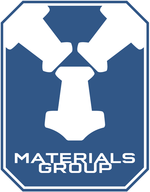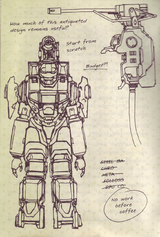Materials Group: Difference between revisions
From Halopedia, the Halo wiki
(Added Infinite armors to their product list.) |
|||
| Line 56: | Line 56: | ||
**[[WARRIOR-class Mjolnir|Warrior]] variant | **[[WARRIOR-class Mjolnir|Warrior]] variant | ||
*[[MJOLNIR Powered Assault Armor (GEN3)]] - The third generation of MJOLNIR armor, replacing the former two MJOLNIR generations. | *[[MJOLNIR Powered Assault Armor (GEN3)]] - The third generation of MJOLNIR armor, replacing the former two MJOLNIR generations. | ||
**[[Mark V Zeta]] variant - Spartans assigned to ONI's [[Xeno-Materials Exploitation Group]] on [[Installation 07]] found that their upgraded Mark V's mix of high-threat response and surveillance interlinks were ideal for the ring's peculiar operating environment.{{Ref/Site|Id=CFParallel|URL=https://www.halowaypoint.com/en-us/news/parallel-threads|Site=Halo Waypoint|Page=Canon Fodder - Parallel Threads|D=25|M=6|Y=2021}} | |||
**[[MJOLNIR Powered Assault Armor/Mark VII|Mark VII]] variant - Though the GEN3 model of Mark VII MJOLNIR does represent a generational leap for the MJOLNIR platform for actively deployed Spartans, some elements tested with the GEN1 and GEN2 Mark VII remain in the prototype stage due to unreliability or cost factors, such as integration of [[Forerunner]]-derived [[Nanotechnology|nanomachine]] elements and full [[Energy shielding|shield]]-shaping.{{Ref/Site|Id=CFDistance|URL=https://www.halowaypoint.com/en-us/news/despite-distance|Site=Halo Waypoint|Page=Canon Fodder - Despite Distance|D=27|M=6|Y=2021}} | |||
**[[SOLDIER-class Mjolnir|Soldier]] variant - The latest iteration of the Soldier helmet features a new revision of Materials Group's combat catalyst firmware. The fireteam synchronization features remain unfinished circa [[2560]], but [[Catherine Halsey|Dr. Halsey]]'s interest may accelerate development.{{Ref/Site|Id=CFShowcase|URL=https://www.halowaypoint.com/en-us/news/showcase-sensitive|Site=Halo Waypoint|Page=Canon Fodder - Showcase Sensitive|D=27|M=6|Y=2021}} | |||
== Known facilities == | == Known facilities == | ||
| Line 82: | Line 85: | ||
*''[[Halo: Fall of Reach]] | *''[[Halo: Fall of Reach]] | ||
**''[[Halo: Fall of Reach - Boot Camp|Boot Camp]]'' | **''[[Halo: Fall of Reach - Boot Camp|Boot Camp]]'' | ||
*''[[Halo 4]]'' | *''[[Halo 4]]'' | ||
*''[[Halo: Nightfall]]'' {{Mo}} | *''[[Halo: Nightfall]]'' {{Mo}} | ||
*''[[Halo 5: Guardians]]'' {{Indirect appearance}} | *''[[Halo 5: Guardians]]'' {{Indirect appearance}} | ||
Revision as of 01:34, June 27, 2021
Materials Group is a division of the Office of Naval Intelligence that is responsible for researching, developing, and manufacturing technologically advanced matériel. The Materials Group's most important development has been the design of the MJOLNIR Powered Assault Armor and the powered exoskeletons which preceded it,[1][2][3] as well as several specialized variant models.[4][5][6][7][8][9]
Known projects
XRP12 Gremlin
During the early years of the Insurrection in the late 25th century, Materials Group developed the X23 Non-Nuclear Electromagnetic Pulse Cannon, which was designed to disable weapons of mass destruction before detonation. Though this technology had existed since the 20th century, the X23 was the first truly precise application of the technology. Once Materials Group deemed that the X23 was a viable tool, it was mounted on a transport chassis; this resulted in the creation of the XRP12 Combat Support Vehicle, commonly known as the Gremlin.[10]
Powered exoskeletons
In 2511, Dr. Catherine Halsey began designing a powered combat suit to complement the Orion Project, Generation II, which would later become the SPARTAN-II program. Materials Group, which had been experimenting powered exoskeletons for at least eleven years,[11] was tasked with developing this system at CASTLE Base on Reach. Materials Group began with the Mark I exoskeleton, which had entered development in 2500;[11] this exoskeleton allowed the wearer to lift nearly two tons and to run at 32 km/h (19.88 mph) for an extended period of time, featured advanced tactical computers that could provide real-time data to the wearer's standard neural interface, and was armed with an integrated 30mm minigun.[11][12] However, the Mark I proved too large and cumbersome, its need to be physically tethered to a power generator, and its potentially fatal hypersensitivity to the user's movement resulted in its abandonment.[11][12]
After the failure of the Mark I, the Materials Group developed the Mark II exoskeleton. The Mark II was considerably slimmer than the Mark I, featured refractive coating for dispersing heat, and possessed improved self-sealing mechanisms for protection against vacuum, though it also had to be tethered to a power source. Thus, the Mark II was also abandoned.[11]
Materials Group then attempted to improve the Mark III exoskeleton, which had been introduced the previous year.[13] Though the Mark III did not have to be physically tethered to a power source, it had to receive broadcast power, similar to an orbital defense platform and its remote generators, and thus still had limited functional range. Furthermore, if the exoskeleton's power flow was disrupted, the operator would become trapped inside. While the Mark III represented a considerable improvement over the two previous models, it was also abandoned. Halsey and Materials Group then accepted that all three exoskeletons were limited by their power sources and would prove impractical in combat.[11][12][14]
HRUNTING/YGGDRASIL
 This section needs expansion. You can help Halopedia by expanding it.
This section needs expansion. You can help Halopedia by expanding it.
MJOLNIR Powered Assault Armor
- Main article: MJOLNIR Powered Assault Armor
Smitten by the perceived failures of the Mark I, Mark II, and Mark III exoskeletons, Halsey decided to completely overhaul the program, starting Project: MJOLNIR. Materials Group was then reassigned to this project, which Halsey felt was the realization of the powered armor program's overall goals.[1][13][14] The team abandoned the "Mark" system used when developing the exoskeletons, as Halsey wished to distance herself and the project from past failures.[15] MJOLNIR, rather than being a bulky powered exoskeleton, would be a self-contained, nearly form-fitting body suit; it would augment the wearer's physical abilities to superhuman levels, though it would require dangerous genetic modification to function safely. The first iteration of MJOLNIR was developed at Materials Group's Damascus Materials Testing Facility on Chi Ceti IV, and was introduced to the recently graduated Spartans on November 27, 2525.
Halsey intended for MJOLNIR to remain a single, continuous system that would be incrementally updated as upgrades became available. However, in 2535 Materials Group mandated that subsequent iterations of MJOLNIR be released in distinct stages as a means of fiscal oversight; thus, against Halsey's wishes, the original version of MJOLNIR was retroactively named the Mark IV, suggesting continuity with the long-abandoned Mark I, II, and III exoskeletons.[16] Materials Group continued to develop the main MJOLNIR series, resulting in several superficially distinct versions which, despite their drastically different appearances, were all classified as the Mark IV due to their internal architecture.[17]
On November 24, 2551, the Mark V generation was introduced.[2][18] This version featured energy shielding technology, which was previously thought to be impossible to reverse-engineer from Covenant technology. It also introduced the ability to accommodate a starship-grade smart artificial intelligence. In late 2552, the Mark VI was introduced. Though it offered few groundbreaking improvements over the Mark V, aside from an automated biofoam injection system, numerous components were refined, making the Mark VI among the most powerful pieces of technology ever created by humanity.
Following the end of the Human-Covenant War the Mark VI was quickly replaced by MJOLNIR GEN2.[19] While the MJOLNIR Mark VII was produced it was not as cost effective or versatile as the GEN2 platform.[20]
MJOLNIR variants
In addition to the main MJOLNIR series, Materials Group developed several purpose-specific variants. Though several other variants have been produced, they were designed by private defense contractors, not by Materials Group.
- MJOLNIR Powered Assault Armor/Mark IV
- Grenadier variant - Developed from early prototypes of the original MJOLNIR (later Mark IV) helmet. Provides superior armor and improved heads-up display to improve performance of grenadiers.[6]
- EOD variant - Designed to increase survivability when in close proximity to an explosion. Developed and manufactured at the Damascus Materials Testing Facility, the development site of the original MJOLNIR.[4]
- EVA variant - One of the earliest MJOLNIR variants. Designed to aid Spartans' mobility, field of view, and endurance during extra-vehicular activity. Developed and manufactured at Materials Group's Low/Zero Gravity Testing Facility in Lister, Aigburth, Ganymede.[5]
- MJOLNIR Powered Assault Armor/Mark V
- Grenadier variant
- HAZOP variant - Introduced as a variant of the Mark V system. Designed to improve survivability in extremely hazardous environments. Prototypes were fielded in the years prior to launch.[7]
- Recon variant - Designed to improve stealth by reducing infrared signature and Čerenkov radiation emissions. Developed at the Beta-5 Division's Ordnance Testing Facility in Swanbourne, Western Australia, parallel to the S variant.[8] After the Human-Covenant War, the Imbrium Machine Complex took ownership of Recon production.
- Scout variant - Designed to improved stealth by reducing infrared signature and Čerenkov radiation emissions. Developed at B5D Ordnance Testing Facility in Swanbourne, Western Australia, parallel to the Mark VI/R variant.
- MJOLNIR Powered Assault Armor/Mark VI
- EOD variant
- EVA variant
- Scout variant
- Recon variant
- Project HAYABUSA - Originally an independent powered armor project by the RKD think-tank, a MJOLNIR-compatible HAYABUSA variant was later developed after Materials Group contacted and pooled resources with RKD.
- MJOLNIR Powered Assault Armor [GEN2] - The second generation of MJOLNIR armor, replacing GEN1 (Mark IV-VII)
- MJOLNIR Powered Assault Armor (GEN3) - The third generation of MJOLNIR armor, replacing the former two MJOLNIR generations.
- Mark V Zeta variant - Spartans assigned to ONI's Xeno-Materials Exploitation Group on Installation 07 found that their upgraded Mark V's mix of high-threat response and surveillance interlinks were ideal for the ring's peculiar operating environment.[21]
- Mark VII variant - Though the GEN3 model of Mark VII MJOLNIR does represent a generational leap for the MJOLNIR platform for actively deployed Spartans, some elements tested with the GEN1 and GEN2 Mark VII remain in the prototype stage due to unreliability or cost factors, such as integration of Forerunner-derived nanomachine elements and full shield-shaping.[22]
- Soldier variant - The latest iteration of the Soldier helmet features a new revision of Materials Group's combat catalyst firmware. The fireteam synchronization features remain unfinished circa 2560, but Dr. Halsey's interest may accelerate development.[23]
Known facilities
- Damascus Materials Testing Facility - When this facility was attacked by the Covenant vessel Unrelenting on November 27, 2525, the SPARTAN-IIs were deployed to destroy the ship, resulting in the death of Samuel-034. The Covenant then deployed a science lance to the facility to retrieve any useful technology,[24] though this incursion was seemingly unsuccessful, as Materials Group held the facility throughout the Human-Covenant War.[6] The Damascus facility's staff developed both the EOD and Grenadier variants of the MJOLNIR system.
- Beta-5 Division Ordnance Testing Facility - This facility was responsible for the parallel development of the Scout and Recon variants of the Mark VI MJOLNIR armor.
- Low/Zero Gravity Testing Facility - This facility developed and manufactured the MJOLNIR EVA variant after the Summa Deep Space Incident, prompting a desire to improve performance in limited-gravity/evacuated environments.[5]
- Weapons Research Facility T12A - This facility's HRUNTING research team was responsible for the development of the HRUNTING Mark III (B) Exoskeleton, commonly known as the Cyclops. Later, HRUNTING was merged with Project YGGDRASIL, leading to the development of the HRUNTING/YGGDRASIL Mark I Prototype Armor Defense System. This facility was attacked by the Covenant during or after 2548, and was destroyed when a sergeant from the UNSC Marine Corps of Engineers activated the self-destruct sequence of the only known HRUNTING/YGGDRASIL suit, killing the invading Covenant forces.[13][25]
- WG/Facility 58-32/B5D - This facility is used to test several GEN2 Mjolnir armor.
- Unidentified facility - This facility is responsible for manufacturing of GEN3 Mjolnir armor.
Gallery
List of appearances
- Halo: The Fall of Reach (First appearance)
- Halo 3 (Indirect mention)
- Halo Legends
- Halo: Reach (Indirect mention)
- Halo: Fall of Reach
- Halo 4
- Halo: Nightfall (Mentioned only)
- Halo 5: Guardians (Indirect appearance)
- Halo: Silent Storm (Mentioned only)
- Become – Step Inside Trailer
- Halo Infinite (Mentioned only)
Sources
- ^ a b Halo: The Essential Visual Guide, page 118
- ^ a b Halo: The Essential Visual Guide, page 119
- ^ Halo: The Essential Visual Guide, page 120
- ^ a b Halo: The Essential Visual Guide, page 65
- ^ a b c Halo: The Essential Visual Guide, page 66
- ^ a b c Halo: The Essential Visual Guide, page 85
- ^ a b Halo: The Essential Visual Guide, page 92
- ^ a b Halo: The Essential Visual Guide, page 152
- ^ Halo: The Essential Visual Guide, page 165
- ^ Halo: The Essential Visual Guide, page 83
- ^ a b c d e f Halo: Encyclopedia, pages 88 and 89
- ^ a b c Halo: The Fall of Reach, page 70, (2001 edition) page 79
- ^ a b c Halo: The Essential Visual Guide, page 44
- ^ a b Halo: The Fall of Reach, page 115 (2001 edition), page 137 (2010 edition)
- ^ Dr. Halsey's personal journal, date ???
- ^ Dr. Halsey's personal journal, January 7, 2535
- ^ Halo Waypoint: The MJOLNIR Project Part 2
- ^ Bungie.net: Bungie Weekly Update - 1/29/10
- ^ Halo: Initiation
- ^ Halo Waypoint: MJOLNIR
- ^ Halo Waypoint, Canon Fodder - Parallel Threads (Retrieved on Jun 25, 2021) [archive]
- ^ Halo Waypoint, Canon Fodder - Despite Distance (Retrieved on Jun 27, 2021) [archive]
- ^ Halo Waypoint, Canon Fodder - Showcase Sensitive (Retrieved on Jun 27, 2021) [archive]
- ^ Halo Wars timeline
- ^ Halo Legends, Prototype





